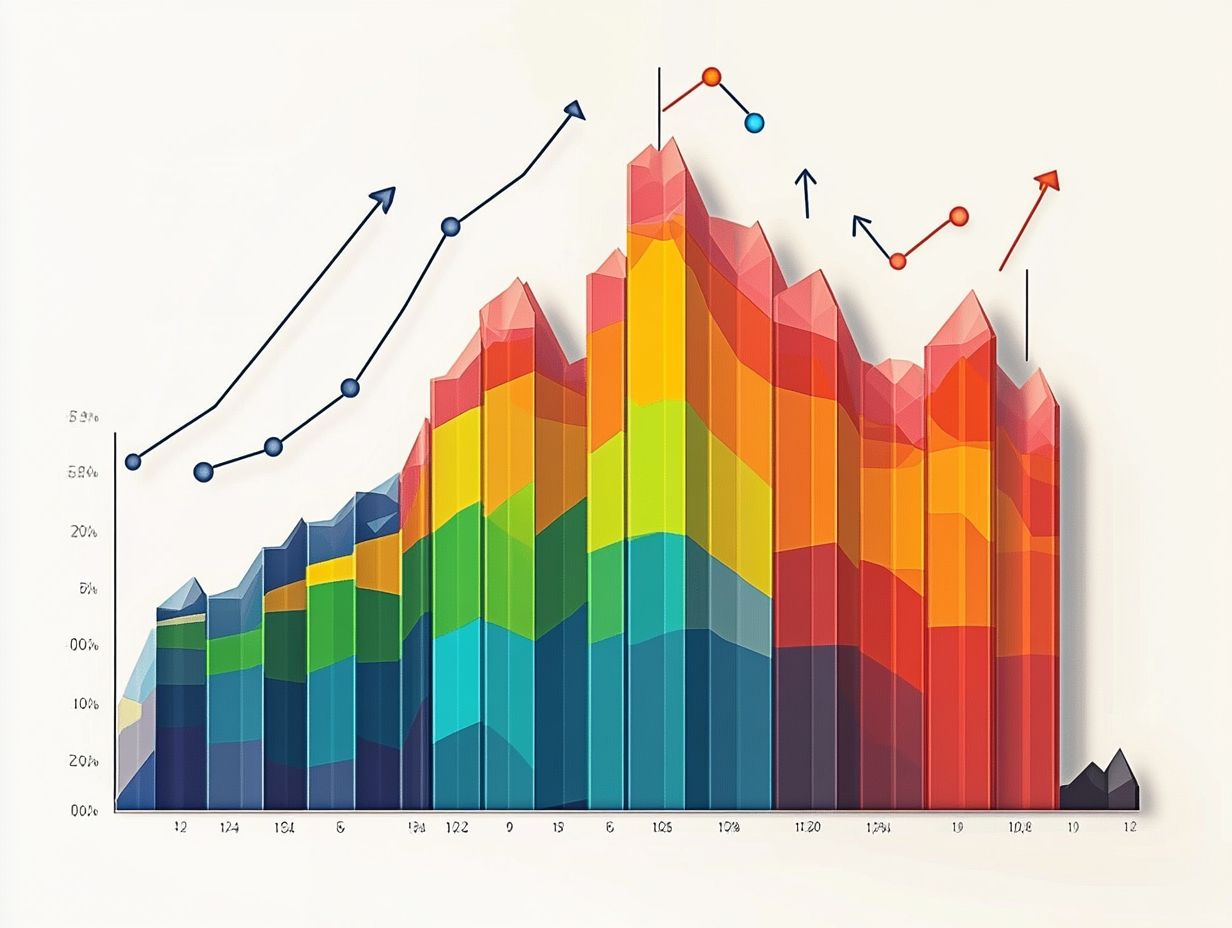Understanding Sector Rotation: A Trend Analysis
Sector rotation is an investment strategy that leverages the cyclical nature of different sectors within the economy. By adjusting your investments from one sector to another, you can aim to maximize your returns based on current economic trends.
This article delves into the definition and purpose of sector rotation, illustrating its importance in shaping your investment strategies. You ll learn how to identify key trends and indicators that can guide your decisions.
Additionally, it discusses various approaches and potential risks while showcasing real-life examples to demonstrate the effectiveness of this strategy.
Explore how sector rotation can elevate your investment portfolio to new heights!
Contents
Key Takeaways:

- Sector rotation is the shifting of investments between different sectors of the economy based on their performance and market trends.
- Understanding sector rotation is crucial. It helps you devise effective investment strategies and optimize portfolio returns.
- Key indicators and metrics, active vs. passive approaches, and potential risks should be considered when implementing sector rotation strategies.
What is Sector Rotation?
Sector rotation is an investment strategy that allows you to shift your allocations among various stock sectors based on the evolving economic cycle. This method takes advantage of the cyclical behavior of the market. Cyclical behavior means that some sectors perform better at different times in the economy. Different sectors shine during different stages, like the early recovery and late recovery phases.
By grasping and anticipating these cycles, you can optimize your portfolio management. This ultimately maximizes your investment returns while mitigating the risks tied to market fluctuations.
Definition and Purpose
The concept of sector rotation centers around the strategic reallocation of your investments across various stock sectors. The objective is to optimize returns based on the economic cycle.
This approach enables you to seize opportunities presented by shifts in market dynamics driven by changing economic indicators, such as GDP growth rates, inflation, and unemployment figures.
For example, when the economic landscape signals a bullish environment, you might consider moving your money toward cyclical sectors like technology and consumer discretionary. These sectors are called cyclical because they do well when the economy is growing.
During economic downturns, shifting your funds to defensive sectors like utilities and healthcare can serve as a safeguard. This helps to mitigate risks and protect your capital.
Grasping these trends not only enhances your portfolio’s resilience but also equips you with the insights needed to make well-informed decisions in response to evolving market conditions.
Why is Sector Rotation Important?
Sector rotation is essential for you as an investor. It offers a dynamic framework to refine your investment strategies in response to current market trends and economic conditions.
By moving your money around across various sectors think defensive sectors like consumer staples and more cyclical options such as transports you can seize opportunities during economic growth in bull markets while safeguarding your capital in bear markets.
This flexible strategy can supercharge your portfolio management and positions you to maximize returns in an ever-evolving financial landscape.
Impact on Investment Strategies
The impact of sector rotation on your investment strategies is nothing short of transformative. This strategy relies on your ability to understand how different sectors react to economic indicators like interest rates, inflation, and GDP growth.
By closely analyzing these metrics, you can pinpoint which sectors are poised to flourish under specific market conditions. For example, during periods of economic expansion, you might find consumer-oriented sectors leading the charge, while defensive sectors could be your go-to during downturns.
By actively adjusting your asset allocation, you position yourself to take advantage of emerging opportunities. This ensures your portfolio remains resilient and in tune with current trends. This dynamic approach highlights the necessity of ongoing market assessment and the continual refinement of your investment strategy.
Start applying sector rotation today to see how it can boost your investment returns!
Identifying Trends in Sector Rotation

Identifying trends in sector rotation is crucial for you as an investor seeking to understand the changing financial markets. By closely monitoring key economic indicators like inflation rates, consumer sentiment, and interest rates you can uncover patterns that signal shifts between market cycles.
These insights enable you to anticipate which stock sectors, such as energy or healthcare, are poised to outperform based on their historical performance during various phases of the economic cycle.
Key Indicators and Metrics
Key indicators and metrics serve as vital tools for you to effectively identify trends in sector rotation, enabling you to make informed investment decisions.
Among these indicators, gross domestic product (GDP) emerges as a cornerstone measure of economic health, reflecting the overall performance of a nation’s economy.
Industrial production provides you with deeper insights into sector dynamics, revealing the levels of output and activity within manufacturing and related industries.
In tandem, the yield curve acts as a crucial barometer of market sentiment; its shape can signal impending economic expansion or contraction.
By analyzing these metrics, you can attain a nuanced understanding of how various sectors respond to shifting economic conditions, enabling you to adjust your strategies and take advantage of new opportunities.
Strategies for Sector Rotation
You can choose between active and passive strategies for sector rotation, each boasting its own distinct advantages and challenges.
Active sector rotation calls for a top-down approach, allowing you to frequently adjust your asset allocation in response to shifting market conditions. On the other hand, passive strategies generally leverage sector ETFs to cultivate a diversified portfolio.
Understanding these approaches is key to managing your portfolio effectively, enabling you to maximize investment returns across various sectors.
Active vs. Passive Approaches
Active and passive approaches to sector rotation present distinct methodologies for managing your investments in the face of fluctuating economic cycles.
With active strategies, you’re frequently buying and selling assets, allowing you to seize opportunities from short-term market movements. This means diving deep into research and having sharp market insight to make quick decisions!
On the other hand, a passive approach focuses on long-term growth, typically involving investments that align with a broad market index. This strategy minimizes transaction costs and allows for a more hands-off management style.
For example, during a recession, you might find active investors pivoting towards defensive sectors like utilities, while passive investors could comfortably remain invested in established index funds that reflect overall market performance. This shows how quickly both methods adapt, helping you take action when it matters most.
Potential Risks and Considerations
While sector rotation offers enticing opportunities, it also carries inherent risks that you must carefully consider to successfully navigate the complexities of financial markets.
Factors like market volatility, shifts in economic indicators, and variations in company fundamentals can significantly influence the effectiveness of your sector rotation strategies.
Therefore, actively managing these risks is vital to protect your investments and grow your wealth. Understanding these risks is crucial for you as an investor, enabling you to protect your capital and strive for sustained investment returns.
Factors to Watch Out for

Stay sharp! Several factors can impact your sector rotation strategies, especially in volatile market conditions.
These factors include geopolitical events that create uncertainty and interest rate changes that influence borrowing costs.
Key economic indicators such as unemployment rates and consumer confidence also play a significant role. Each of these influences sends ripples through different sectors. For instance, higher interest rates might squeeze growth stocks while providing a boost to financials.
Geopolitical tensions can also affect commodities, leading to price fluctuations.
Understanding these dynamics helps you make informed decisions, adapting your investment strategies to seize potential opportunities while effectively mitigating risks.
Case Studies: Successful Sector Rotation Examples
Examining case studies of successful sector rotation provides you with invaluable insights into effective investment strategies that leverage prevailing market trends.
These examples illustrate how you can adjust your allocations among sectors like financials, materials, and technology to optimize returns throughout various phases of the economic cycle, from market bottoms to bull markets.
By analyzing these scenarios, you can glean essential lessons about timing and strategic decision-making in sector rotation, enabling you to make more informed investment choices.
Real-Life Examples and Lessons Learned
Real-life examples of sector rotation offer valuable insights for you as an investor looking to refine your investment strategies.
Take, for instance, the recovery period following the 2008 financial crisis. Many astute investors shifted their attention from the financial and consumer discretionary sectors to technology and healthcare.
By keenly observing economic indicators and market trends, they seized the growth potential in these areas, resulting in substantial returns on their investments.
A notable strategy involved reallocating assets into sectors that typically perform well during inflationary periods, such as utilities and materials.
These approaches highlight the significance of timing and analysis in sector movement, demonstrating that informed decisions can lead to enhanced portfolio performance.
By understanding the indicators that signal these shifts, you can undoubtedly shape your future investment strategies with greater confidence.
Frequently Asked Questions
What is sector rotation?
Sector rotation is a strategy used in investing where an investor continuously shifts their investments between different sectors of the economy based on market trends and economic conditions. Sectors refer to distinct segments of the economy, such as technology or healthcare.
Why is understanding sector rotation important?

Understanding sector rotation allows investors to identify potential shifts in market trends and allocate their investments accordingly, potentially maximizing their returns and minimizing risk.
How is sector rotation different from market timing?
Sector rotation involves shifting investments between different sectors within the market, while market timing involves trying to predict the overall movement of the market. Sector rotation is a more focused strategy, while market timing is a broader approach.
What are some common sectors that investors rotate between?
Some common sectors that investors rotate between include technology, healthcare, consumer goods, energy, and financials.
Can individual investors implement sector rotation strategies?
Yes, individual investors can implement sector rotation strategies by diversifying their portfolio and actively monitoring economic data and market trends to determine when to rotate their investments between sectors.
What are the potential risks of sector rotation?
One potential risk of sector rotation is the possibility of missing out on potential gains in a particular sector if the timing of the rotation is not accurate. Continuously shifting investments can also lead to higher transaction costs.
For more information on implementing effective sector rotation strategies, feel free to reach out!






